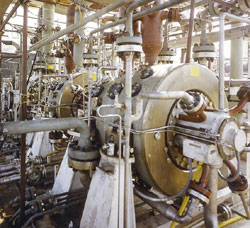Italy: Ultra-high-pressure compressors are being developed
Apr. 2002 Vol. 223 No. 4 European Technology Round Up
Increasing oil demand and progressive depletion of existing fields are prompting oil companies to explore and develop oil fields in harsh and remote areas, in deeper seas, at greater drilling depths and in fields producing crudes with lower API gravity and high sulphur content. Associated gas must be reinjected at pressures exceeding current experience to enhance oil production and avoid flaring. Reinjection of sour associated gas, containing a high percentage of sulfur and carbon dioxide, is required more often, since it frees the user from gas treating and sulfur disposal. This continuous shift to more severe environmental and operating conditions requires edge solutions for the rotating equipment to handle these gas characteristics and higher pressures, while also maintaining a high reliability. Only companies with proven experience, advanced prediction and design tools, rigorous methodologies and capability to approach new problems can give the operator the necessary confidence to make further steps ahead. GE Oil & Gas Nuovo Pignone (NP) has extensive experience in ultra-high-pressure reinjection. The world’s first centrifugal unit was successfully full-load tested at 10,000 psia (700 bar) in Florence in 1975. Prior field experience included reinjection pressures up to 9,150 psi (630 bar), but recent studies have looked into reinjection trains handling sour gas at discharge pressures up to 11,800 psi (820 bar).
Constant interaction and open attitude between oil company specialists and the manufacturer are necessary to develop suitable solutions to meet the user’s requirements. A rigorous interactive process was set up with the user and critical suppliers to co-develop a suitable train configuration and define all the technical features. For this goal, the DFSS (Design for Six Sigma) methodology was adopted. It is based on a number of tollgates that must be passed to progress with the conceptual and design / fabrication to a point where validation of results is confirmed by experimental tests. The basic steps were: prove compression system feasibility, identify technology gaps from previous experience and define specific action plans to mitigate risks. The areas covered by this process include the following: Modeling techniques and performance. Validation of the thermodynamic code for performance prediction, (confirmed by numerous full-load tests and site-test results) extended to gas compositions with high H2S and CO2 content and pressures up to 14,000 psia (1,000 bar). Rotating stall prediction. New design rules eliminate risks. A thorough experimental program was conducted in early 2000 to characterize the remedies and their impact on efficiency. Labyrinth technology and rotordynamics. NP’s philosophy in the design of high-pressure compressors is to maximize shaft stiffness and reduce rotor sensitivity to aerodynamic excitation by optimizing bearing dampening effects and labyrinth design. Shaft end seals. Tandem, dry-gas seals for high-pressure natural gas sour service, designed for 6,150 psi (425 bar), were developed jointly with leading suppliers and tested during 2001. Compressor casing and head seals. An upgraded casing design was developed to accommodate higher pressure, including an optimized head-seal configuration to avoid possible extrusion phenomena at the highest pressures. Material selection: Materials were identified for handling operational references in high-pressure, sour services and the level of dehydration necessary. Further R&D is aimed at developing solutions for ultra-high-pressure (UHP) compressor trains to face future industry requirements. These units will produce discharge pressures to 14,000 psi (1,000 bar). Project scope addresses thermodynamics, material selection, casing design optimization, seal system design, aerodynamics and lateral and torsional analysis. This is required to assess all risk areas and develop and validate prediction and design models by advanced simulation tools and continuous verification by experimental tests. |
|||||||||||||
- What's new in production (February 2024)
- U.S. operators reduce activity as crude prices plunge (February 2024)
- U.S. producing gas wells increase despite low prices (February 2024)
- U.S. oil and natural gas production hits record highs (February 2024)
- Dallas Fed: E&P activity essentially unchanged; optimism wanes as uncertainty jumps (January 2024)
- Mixed outlook for activity on the UK Continental Shelf (December 2023)




